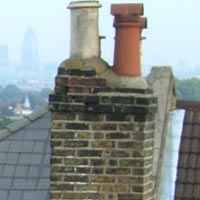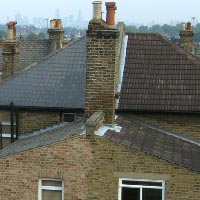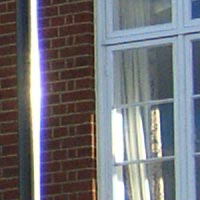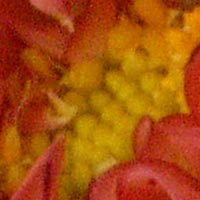Ricoh Caplio GX8
Review Date: October 13th 2005
|
Image Quality
All of the sample images in this Review were taken using the F3264 image quality/size setting, which gives an average image size of around 3Mb.
Noise
There are 6 ISO settings available on the Ricoh Caplio GX8 which you can select at any time if the camera is in either the Auto or A/M modes. Here are some 100% crops which show the noise levels for each ISO setting:
ISO 64 (100% crop) |
ISO 100 (100% crop) |
 |
 |
ISO 200 (100% crop) |
ISO 400 (100% crop) |
 |
 |
ISO 800 (100% crop) |
ISO 1600 (100% crop) |
 |
 |
The noise levels look fine at ISO 64 and 100, but there's already quite a lot of noise starting to appear at ISO 200 and the image quality has deterioated very badly at ISO 400. The Ricoh Caplio GX8 offers fast speeds of ISO 800 and 1600, but they are so noisy as to be completely unusable.
Sharpening
Here are two 100% crops which have been Saved as Web - Quality 50 in Photoshop. The right-hand image has had some sharpening applied in Photoshop. The out-of-the camera images at the default sharpening setting of Normal are perfectly fine and don't really benefit from any further sharpening in a program like Adobe Photoshop. If you don't like the default setting the Ricoh Caplio GX8 also offers Sharp and Soft settings.
Original 100% Crop |
Sharpened 100% Crop |
 |
 |
 |
 |
File Quality
The Ricoh Caplio GX8 has 6 different JPEG file quality settings available, with F3264 being the highest quality option. Here are some 100% crops which show the quality of the various options, with the file size shown in brackets.
|
F3264 (3,112Kb) |
N3264 (1,743Kb) |
 |
 |
|
N2592 (1,137Kb) |
N2048(704Kb) |
 |
 |
|
N1280 (394Kb) |
N640 (95Kb) |
 |
 |
Chromatic Aberrations
The Ricoh Caplio GX8 suffers badly from quite excessive chromatic aberrations in both bright outdoor conditions where there is high-contrast, and in situations where you might not expect it to occur. Examples 2 and 3 below are typical situations in which purple fringing occurs - a structure against a bright white sky and a chrome object respectively. Perhaps more worrying are Example 1, a dull day in London, and Example 4, a sunny day with deep blue skys.
|
Example 1 |
Example 2 |
 |
 |
|
Example 3 |
Example 4 |
 |
 |
Macro
The Ricoh Caplio GX8 offers a Macro setting that allows you to focus on a subject that is just 1 cm away from the camera. The first image shows how close you can get to the subject in Macro mode (in this case a compact flash card). The second image is a 100% crop.
|
Macro Shot (click to view full-sized image) |
100% Crop |
Flash
The flash settings on the Ricoh Caplio GX8 are Auto, Red-eye Reduction, On, Slow Synchro, Off. These shots of a magnolia coloured wall were taken at a distance of 1.5m.
|
Flash Off - Wide Angle (28mm) |
Auto Flash - Wide Angle (28mm) |
 |
 |
|
Flash Off - Telephoto (85mm) |
Auto Flash - Telephoto (85mm) |
 |
 |
And here are some shots of yours truly. As you can see, neither the Flash On setting and the Red-Eye option caused any red-eye, but there is heavy vignetting (dark corners) and the overall image is underexposed.
|
Flash On |
Flash On (100% Crop) |
 |
 |
|
Flash - Red-Eye Reduction |
Flash - Red-Eye Reduction (100% Crop) |
 |
 |
Night Shot
The Ricoh Caplio GX8 maximum shutter speed is 30 seconds, which is good news if you're seriously interested in night photography. The shot below was taken with a shutter speed of 30 seconds, aperture of f/6.0 at ISO 64. I've included a 100% crop of the image to show what the quality is like.
|
Night Shot (click to view full-sized image) |
100% Crop |
 |
|
Overall Image Quality
The Ricoh Caplio GX8 produced images of poor quality during the review period. The two big problems for this camera are noise and chromatic aberrations. The 8 megapixel sensor used in the Ricoh Caplio GX8 may result in larger images, but it comes at the cost of noisy images even at the slower ISO settings. ISO 50 and 100 look fine, but there's already quite a lot of noise starting to appear at ISO 200, which isn't exactly a quick speed. ISOs 400, 800 and 1600 are all something of a last resort option. The Ricoh Caplio GX8's dealt badly with chromatic aberrations, which appeared in many of the test shots, with obvious purple fringing effects apperaing in a variety of different lighting conditions and subjects. On a more positive note, the sharpening level at the default setting of Normal is fine (and can also be increased or decreased in-camera) and macro performance is nothing short of amazing, allowing you to focus as close as 1 cms away from the subject. The built-in flash worked poorly indoors with vignetting at the wide-angle lens setting and overall under-exposure. The quality of the night photograph was good, with the maximum shutter speed of 30 seconds being great news for taking photos after dark.
Appendix: Does Sharpness Affect the Overall Image Quality?
A PhotographyBLOG reader (thanks, Prognathous) has suggested to me that setting Sharpness to Soft, rather than the default of Normal, would improve the overall image quality. So here are some comparison shots of the 3 different sharpness settings (all other parameters were identical):
Soft (ISO 64) |
Soft (ISO 200) |
 |
 |
Normal |
Normal |
 |
 |
Sharp |
Sharp |
 |
 |
A side-by-side comparison reveals that there are slightly less artifacts in the Soft shots than the Normal shots, but you would expect this to be the case. For me, the Soft shots are not sharp enough and would require further sharpening in Adobe Photoshop anyway, although this is probably the best method to follow as the camera's Normal setting does introduce quite a lot of artifacts. Noise at ISO 200 and faster is still present at all three Sharpness settings. So setting the Ricoh Caplio GX8 does seem to improve image quality slightly at the lower ISO settings, but this comes at the cost of having to sharpen all of of your images later in Photoshop or similar. Also, it doesn't solve the issue of high noise levels at ISO 200 and faster.
|
 PhotographyBLOG is a member of the DIWA organisation. Our test results for the Ricoh Caplio GX8 have been submitted to DIWA for comparison with test results for different samples of the same camera model supplied by other DIWA member sites.
PhotographyBLOG is a member of the DIWA organisation. Our test results for the Ricoh Caplio GX8 have been submitted to DIWA for comparison with test results for different samples of the same camera model supplied by other DIWA member sites.



